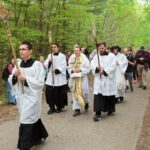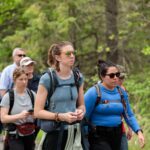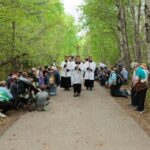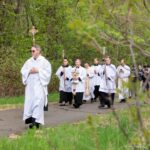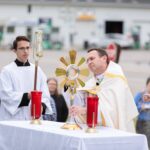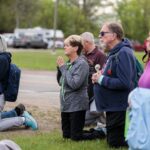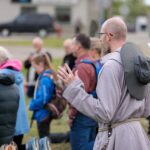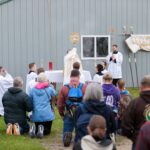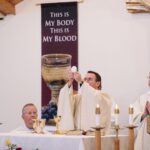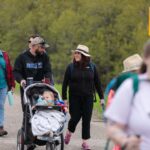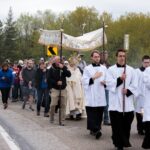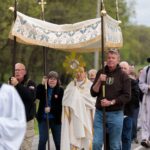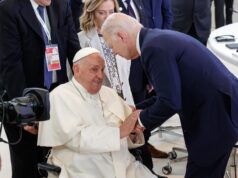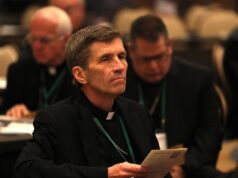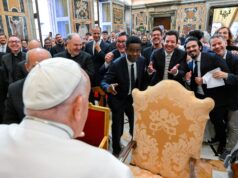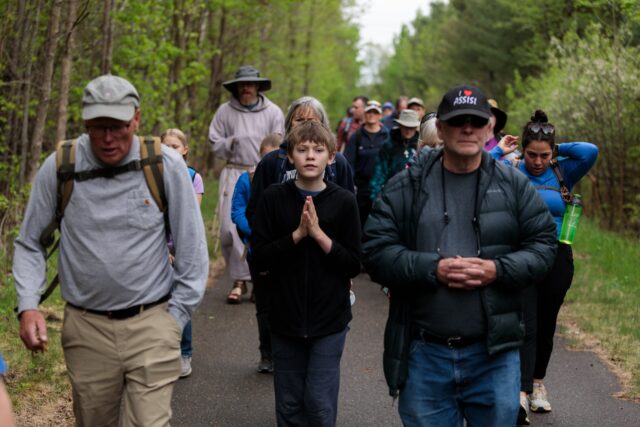
WALKER, Minn. — At a temporary altar in front of a gray corrugated steel park shelter, Bishop Andrew H. Cozzens and about 30 pilgrims knelt in the wet morning grass for benediction May 20. The prayers were part of a transition from a 1-mile solemn procession following 7:30 a.m. Mass at St. Theodore Catholic Church in Laporte, to a 12-mile “simple” procession from Laporte to Walker, where a Holy Hour was scheduled for mid-afternoon.
After the perpetual pilgrims and other volunteers dismantled the altar and stored the processional canopy, candles and altar linens, Bishop Cozzens, who leads the Diocese of Crookston, took up the montrance and crossed the street to the trail, where he and fellow pilgrims would walk for the next six hours among pines, birches and marshland.
Laporte, population 134, had been the first stop for the National Eucharistic Pilgrimage’s Marian Route, which began the day before in nearby Itasca State Park. An estimated 2,500 people attended an outdoor Mass near the park, with about 1,700 of them processing behind the Eucharist for a mile into the park near the Mississippi River headwaters. From there, a much smaller procession continued 5 miles to the park’s edge.
The route’s “perpetual pilgrims” — six young adults and two seminarians, plus two chaplains — then took vehicles 22 miles to Laporte, with the perpetual pilgrims continuing adoration in their van, the monstrance secured to the top of a custom-made tabernacle. That evening, they attended a Holy Hour at St. Theodore before spending the night with a host family.
The pilgrimage’s second day included one of the longer stretches the Marian Route pilgrims will walk with other day pilgrims during their eight-week journey to Indianapolis for the July 17-21 National Eucharistic Congress. Elsewhere in the U.S., perpetual pilgrims on the pilgrimage’s other three routes are also enroute to the Indiana capital, but none in such rural environs as Minnesota’s Northwoods.
In Texas, pilgrims on the St. Juan Diego Route spent the day in San Benito and Harlingen. In Connecticut, the St. Elizabeth Ann Seton Route’s pilgrims zigzagged across the state, west from Bridgeport and Fairfield to Ridgefield in the foothills of the Berkshire Mountains, and then back to Norwalk on the Long Island Sound. In California, pilgrims on the St. Junipero Serra Route were in Greenbrae and San Rafael on the western side of San Francisco Bay before heading to Sacramento.
In Northern Minnesota, the Marian Route pilgrims walked along the Paul Bunyan State Trail, a paved rail trail popular with bikers, cyclists and, in winter, snowmobilers. Accompanied by birdsong and the drone of the occasional car passing on the adjacent highway, they prayed the rosary and Divine Mercy Chaplet, and sang hymns and praise songs. Perpetual pilgrim Danielle Schmitz and Brother Damien Joseph Novak, a member of the Franciscan Friars of the Renewal and one of the route’s chaplains, took turns playing guitar.
Sometimes the pilgrims walked stretches in silence or quiet conversation, sharing both jokes and faith testimonies. Some fell to the back of the procession to talk at length, or even to pick morel mushrooms sprinkled along the trail.
The walk began with about 25 pilgrims, most of whom had been at Mass, with another 20 from St. Mary’s Cathedral in Fargo, North Dakota, joining at a crossroads a few miles into the journey. As the procession approached their bus, they knelt in adoration. Bishop Cozzens stopped to bless and pray with them before they merged into the group. Some pilgrims walked a mile or two before meeting a ride along the road, while others went the full way to Walker, a resort town on Leech Lake.
Most of the day pilgrims were locals, such as Taylor Knight, the faith formation director at Walker’s St. Agnes Catholic Church, who pushed his nearly 2-year-old son, George, the full route in a stroller. Others, such as Jamie Easley and her sister Terri Tanski, joined from considerable distances to be part of the historic event.
“This in our lifetime is unprecedented, and to bring Jesus like this into the world at large is so powerful,” said Easley, 62, who lives in Dubuque, Iowa. “I think he’s going to touch lives along the way just by his mere presence in the monstrance as we process.”
Tanski, 60, compared the event to the processions she remembered from their childhood.
“When we found out that Jesus was going to walk among his people, I’m like, I’ve got to be with him. … You can’t have him walk through the streets and nothing happens. Stuff is going to happen, and I had to just be here with him,” said Tanski, who is from Arcadia, Michigan, near Traverse City.
After the sisters had traveled so far, Easley said, “we were laughing because here’s Jesus under the guise of the host, and all of this is his,” indicating the woods around her. Tanski interjected: “We’re thinking we’re doing something great for him, but really he’s just sharing it with us, right?”
The National Eucharistic Pilgrimage and National Eucharistic Congress are highlights of the National Eucharistic Revival, an effort launched by the U.S. bishops in 2022 to renew love for and understanding of Jesus’ real presence in the Eucharist. In roles for the U.S. Conference of Catholic Bishops and as board chairman of National Eucharistic Congress Inc., Bishop Cozzens has been instrumental in leading the revival and its national events.
Easley said she appreciated the bishops’ leadership initiative with the revival.
“We like when they (the bishops) step out of their comfort zone and do something like this,” she said. “It bolsters our Catholic identity, and it lets us know that we’re not alone. They’re willing to put themselves out there on behalf of the church and of us.”
The Marian Route’s perpetual pilgrims — Sarah Cahill, Matthew Heidenreich, Danielle Schmitz, Jennifer Torres, Kai Weiss and Megan Zaleski — were attentive to the needs of the others walking: They led decades of the rosary, helped the group make way for passing cyclists, and quietly conversed with the pilgrims who had joined.
For her part, Torres, who grew up near Chicago and then Nebraska, and now lives in Denver, carried water for the seminarians who wore cassocks, not backpacks, as they walked with a processional cross and candles flanking the monstrance. Tied to her pack was a bandana printed with Marian symbols that has accompanied her to Marian shrines in Mexico and Europe.
On the second day of the National Eucharistic Pilgrimage, Torres, said that her experience so far was “a great mix” of the things she loved from previous pilgrimages.
“I appreciate when there’s moments … of smaller groups (walking). There’s more silence, there’s more focus on just the dialogue with you and the Lord,” the 28-year-old said. “But nothing beats Sunday’s first solemn procession with those thousands of people behind us. I think there’s a message being sent into the world of ‘there’s always a space for you here,’ and you can always have that same profound experience of intimacy in smaller processions.”
Mike Wavra, 66, from Thief River Falls, Minnesota, walked several miles of the pilgrimage, which is something he had long anticipated. At one point, he and his wife considered following the pilgrims for a week or two with their camper and electric bikes. Changes to the pilgrimage’s logistics altered their plan, but they expect to rejoin the pilgrims in Indianapolis.
“I was so excited just to be able to walk with Jesus,” Wavra said. “I hadn’t seen a Eucharistic procession since I was a kid, and now we’ve had them in our own parishes. Now we’re doing this one. These are the things that are going to bring people back to Christ. You’ve just got to open your heart and let him in, and you’re going to want to walk.”
Along the route, the pilgrims crossed from the Diocese of Crookston to the Diocese of Duluth. The pilgrims stopped midday for a picnic in the backyard of a St. Agnes family whose property backed up to the trail. They continued along Leech Lake, walking by simple fishing cabins and upscale resorts. When they entered Walker, they stopped in a parking lot for benediction and continued in a solemn procession, the Eucharist under the canopy.
Some onlookers stopped to watch, some knelt. One man continued to wash his car as the pilgrims passed his driveway. A couple of young men from the local outdoors outfitters stood along the route, telling Cahill, who greeted them, that they knew some people who were walking. Other young adults leaned out of the drive-through window of a fast food restaurant to watch, and, on the lake, a person honked and waved from a passing pontoon.
St. Agnes’ bells tolled, growing louder to the pilgrims as they approached. They went through a tunnel under the road with the sign “Walker” and one joked, “That’s us!” When they arrived at the church, dozens of men and women were there, anticipating Eucharistic adoration. Among them was Bishop Daniel J. Felton of Duluth, who would join the perpetual pilgrims, as well as Bishop Cozzens, as they continued on that evening to Minnesota’s Grand Rapids.
After a short time in silent adoration, Bishop Cozzens read from the Gospels and then preached on “awakening” one’s faith in Jesus in the Eucharist, letting him transform their lives.
“It’s been beautiful for us to walk with him, to pray with him and simply to ask him that he would pour out his grace as we go, even on people who don’t know him,” he said.
Noting the birdsong along the route, Bishop Cozzens said, “I thought that, the birds — they know who he is. The trees, the skies, they recognize their Creator when he is coming. And then it was beautiful that the bells were ringing when we came here. I kept thinking to myself, ‘The King is coming. The King is coming,’ right? And the people know the King is coming.
“My only request for you,” he continued, “is that you give thanks to the Lord for this great opportunity to make the pilgrimage you made today, and ask for that increase of faith, (and) that you pray for those going forward.”
As the perpetual pilgrims prepared to leave the church, they collected written prayer requests and left instructions on how to share more online. They said goodbye to those they had walked with that day and climbed into their van for the 60-mile drive to Grand Rapids.
As they pulled away, the monstrance holding the Eucharist was visible through the van’s large windows, showing their procession would continue as they headed eastward.




